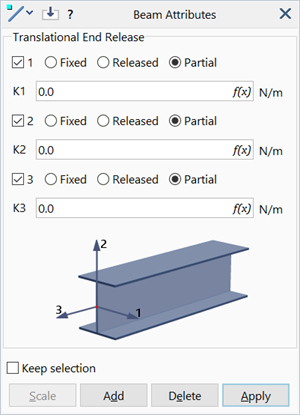Beam Attributes: Translation End Release

Description
Assigns translational releases to selected ends of beam elements, with respect to the directions of the principal axes.
End releases change the way the end of the beam is connected to the node; translational end releases can be Fixed, Released or Partial.
Translation end release attributes may be applied to beam element types, user-defined beams, pipe elements and spring elements.
In nonlinear geometric analysis, only the axial translation release is supported (3 axis). Lateral direction releases (1 and 2 axes) are not supported.
In some cases, end releases can produce a structure with a singular stiffness matrix. For example, fully releasing both ends of a beam in the 3 axis direction will result in a translational rigid body mode due to the fact that the beam is detached from both nodes in the axial direction.
Translation end release attributes are independent of load and freedom cases.
Dialog
Translation End Releases 1 / 2 / 3
Three components in the beam's principal axis system. Each component has three options that determine the state of the release in that direction:
-
Fixed
This is the default connection condition between the beam end and its node. A fixed condition means that there is no release, and the beam end it fully attached to the node.
-
Released
The beam end is completely disconnected from the node. The end of the beam is free to move independently of the node, in the released direction.
-
Partial
The beam end is attached to the node via a translational spring with a prescribed stiffness. The spring provides the specified stiffness along the selected axis.
K1 / K2 / K3
The translational spring stiffnesses along the 1, 2 and 3 beam principal axes, respectively.
Applicable to Partial releases only.
Common Controls
Units
Force/Length (e.g., N/m, lbf/in).
Common Uses
A slotted bolted joint can be modelled using the translational end release attribute. The slot is orientated along the axis of the beam and allows the beam to move in this direction. The beam is restrained in the other two directions by bolt shear and by bolt tension. A single translation end release could be applied to release the translation of the beam from the node in the axial direction (3 axis) while it remains connected to the node in the lateral directions (1 and 2 axes).
See Also